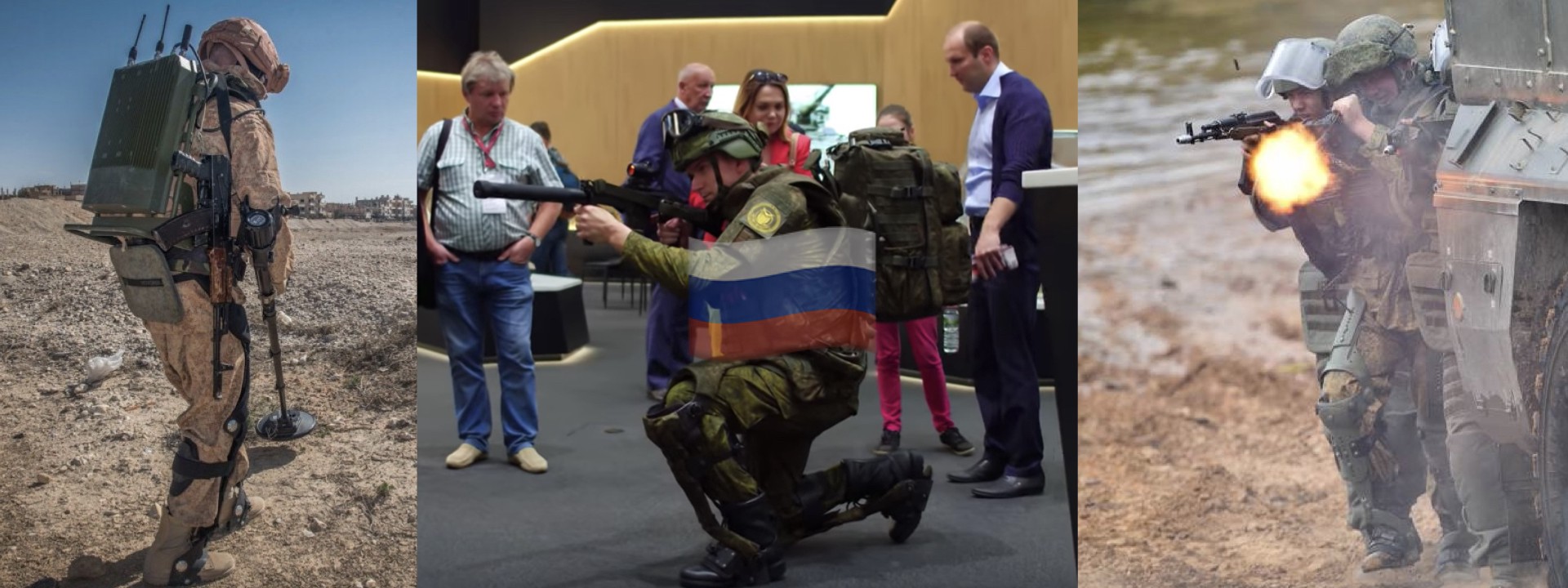Russian Exoskeletons on the Fast Track to the Battlefield
Latest photos from Russian Ministry of Defense reveal active functionality of the military exoskeletons
Russian Exoskeletons on the Fast Track to the Battlefield

(Source: @LAndriukaitis/DFRLab via Soldier Systems/archive, left; RT/archive, middle; topwar.ru/archive, right)
A new photo shows that Russia is continuing to push their military exoskeletons to full combat readiness.
As a number of countries are currently rushing to develop their own exoskeletons for military use, Russia’s design is close to full combat operability. Meanwhile, China is working on adopting a similar design, called the Norinco exoskeleton, and the United States is also developing, in cooperation with Lockheed Martin, an exoskeleton by the name of ONYX. The release date for either of these models, however, is unknown.
An exoskeleton is wearable device that provides the soldier additional strength and endurance in limb movement. Depending on the model, the exoskeleton allows the user to carry additional weight, while also helping them stabilize and hold their weapons. These devices can either be powered by batteries (active) or used without external energy sources (passive).
The Russian military’s passive exoskeleton, the “K-2,” is already in limited use. The first public use of these devices was as early as July 2017. Russian combat engineers were allegedly photographed using these suits for demining operations in Palmyra, Syria, but the imagery confirming their use is scarce.
A visual analysis of the few images that do exist, however, shows that the K-2 model recorded in 2017 was a prototype, as the newer photos of the exoskeleton differ slightly. According to various sources, the exoskeleton allows the user to carry up to 50 additional kilograms without experiencing significant muscular fatigue. In the newly surfaced image, the additional weight carry function was presented as the soldier had a weapon system attached.

The same, but slightly upgraded, suit was also presented in the “Army-2018” International Military-Technical Forum, the Russian government’s annual military technology exhibition. The suit was presented in a closed environment, with a soldier slowly walking around in it to demonstrate its moving capabilities.
At the “Army-2018” Forum, this exoskeleton was presented as a finished product. Furthermore, the soldier was carrying a rifle with the suit, showing that the system can be used not only for combat support operations, such as demining, but combat operations as well. Yet, during the forum, the rifle was not integrated into the exoskeleton system, thus in 2018 the primary function of weight carry was not on display.
At the “Army-2019” Forum, the Russian military displayed the same suit’s abilities in an active exercise. During this year’s forum, demonstrators tested a variety of Russian military equipment in a water-crossing exercise. In one of the few photos, provided by the Russian Ministry of Defense, a soldier wearing the K-2 exoskeleton fires a machine gun while moving. This exercise showed that the exoskeleton is ready for use in active military maneuvers, including firing a machine gun efficiently while on the move. This photo serves as the most current update on the system’s development and shows that Russia might be one step ahead of other countries in fully implementing this system into its forces.

Russia is also currently developing another exoskeleton design that appears more futuristic and further from actual combat use. The Ratnik-3 model is a more advanced version than the K-2, providing the user with something closer to full-body protection. Currently, the design is planned to be operable by 2025.
A variety of other exoskeleton designs are currently under development by other countries. The Russians demonstrated that their K-2 exoskeleton is close to combat ready, while the Chinese and U.S. passive exoskeletons, despite their similarities in design to the K-2, have yet to be photographed in a battle-ready setting.
Follow along for more in-depth analysis from our #DigitalSherlocks.

